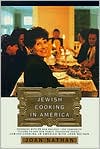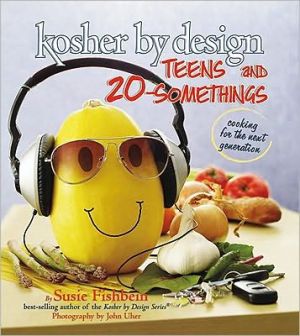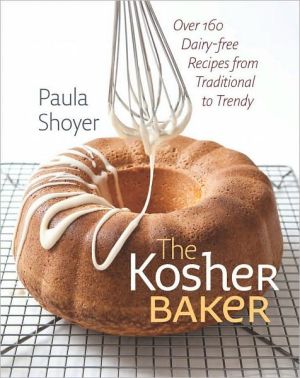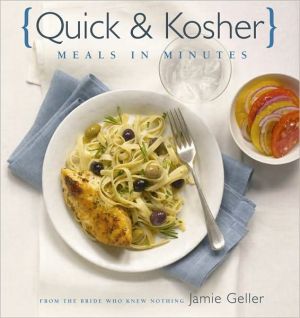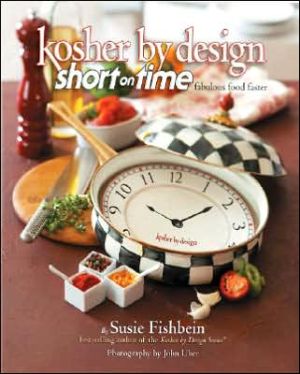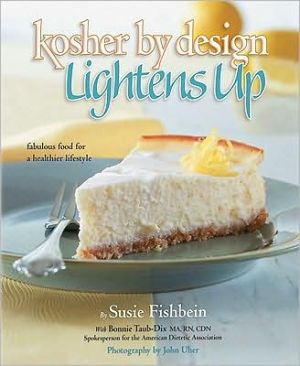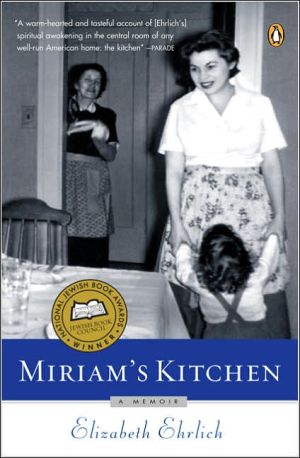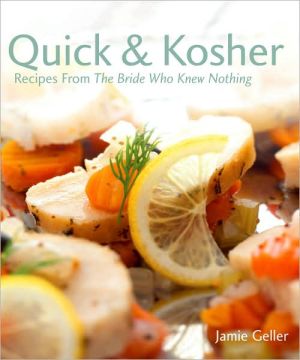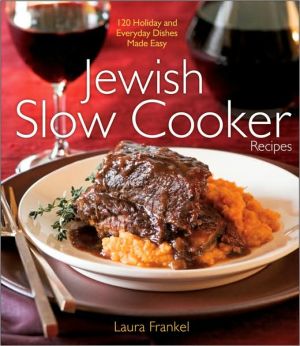Jewish Cooking in America
This rich tapestry of more than three centuries of Jewish cooking in America gathers together some 335 kosher recipes, old and new. They come from both Sephardic and Ashkenazic Jews who settled all over America, bringing with them a wide variety of regional flavors, changing and adapting their traditional dishes according to what was available in the new country.\ What makes Jewish cooking unique is the ancient dietary laws that govern the selection, preparation, and consumption of observant...
Search in google:
This rich tapestry of more than three centuries of Jewish cooking in America gathers together some 335 kosher recipes, old and new. They come from both Sephardic and Ashkenazic Jews who settled all over America, bringing with them a wide variety of regional flavors, changing and adapting their traditional dishes according to what was available in the new country.What makes Jewish cooking unique is the ancient dietary laws that govern the selection, preparation, and consumption of observant Jews. Food plays a major part in rituals past and present, binding family and community. It is this theme that informs every part of Joan Nathan’s warm and lively text. Every dish has a story–from the cholents (the long-cooked rich meat stews) and kugels (vegetable and noodle puddings) prepared in advance for the Sabbath, to the potato latkes (served with maple syrup in Vermont and goat cheese in California) and gefilte fish (made with white fish in the Midwest, salmon in the Northwest, haddock in New England, and shad in Maryland). Joan Nathan tells us how lox and bagels and Lindy’s cheesecake became household words, and how American products like Crisco, cream cheese, and Jell-O changed forever Jewish home cooking.The recipes and stories come from every part of the U.S.A. They are seasoned with Syrian, Moroccan, Greek, German, Polish, Georgian, and Alsatian flavors, and they represent traditional foods tailored for today’s tastes as well as some of the nouvelle creations of Jewish chefs from New York to Tuscon. When Jewish Cooking in America was first published in 1994, it won both the IACP / Julia Child Cookbook Award for Best Cookbook of the Year and the James Beard Award for Best Food of the Americas Cookbook. Now, more than ever, it stands firmly established as an American culinary classic. Publishers Weekly You don't have to be Jewish to like the latest entry in the Knopf Cooks American series. You don't even have to like Jewish cooking. A food-lover's guide to Jewish American history and culture, it dishes up not just recipes but appetizing anecdotes, insights about various forms of religious observance and how they have been affected by transplantation to the New World, even a few jokes. Nathan ( Jewish Holiday Kitchen ), a skillful writer and an energetic researcher, evokes the greenhorn's astonishment at the plentitude of oranges; documents the ``revolution'' in kosher cooking inspired by the introduction of vegetable shortening in the '10s; explains how enterprising Jewish admen convinced various food manufacturers to tailor their products for kosher consumers; calls on Southern families who replace the walnuts and almonds of Eastern European cookery with pecans, and visits Maine cooks who prepare mock lobster salad. Her focus is expansive, covering not just standard Ashkenazic and Sephardic dishes and traditions but foods and customs from Bukhara, Salonika, Israel and Georgia as well as original Jewish American hybrids. The recipes themselves, clearly outlined if not always easy to execute, constitute something of a Jewish culinary hall-of-fame, with faithfully preserved instructions for homemade bagels and pickled herring, Lindy's cheesecake and contributions from chic restaurateurs (Wolfgang Puck, Anne Rosenzweig). Illustrations not seen by PW. BOMC alternate, HomeStyle Book Club alternate. (Mar.)
Soufganiyot—Israeli Hanukkah Jelly Doughnuts\ About 24 doughnuts\ Every baker in Israel worth his dough makes thse jelly doughnuts for Hannukkah. Soufganiya, the modern Israeli word for a doughnut stuffed with jam, also called ponchik in Russian, comes from the Gree sufgan ("puffed," "fried," and "spongy") and from the Hebrew sofiget ("water) and sofeg ("to blot"). It is typical of new Israeli words that they are sometimes inspired by the Arabic, by the Hebrew, or by other languages, and sometimes just invented; but they are all deeply discussed by the Academy of the Hebrew Language before being incorporated into the lexicon.\ In the beginning, a soufganiya consisted of two rounds of dough sandwiching some jam, but the jam always fell out during the frying. Today, with new injectors on the market, balls of dough can be deep-fried first and then injected with jam before being rolled in sugar. This is a much easier and quicker way of preparing the doughnuts, and no jam escapes during cooking. This recipe is adapted from that of Bulgarian-born Sophi Ashkenazi, one of Tel Aviv's leading caterers. It is perhaps the only distinctly Israeli holiday dish.\ 1 package dry yeast\ 3 tablespoons sugar\ 1/4 cup lukewarm water\ 3 1/2 cups unbleached all-purpose flour (about)\ 1/2 cup lukewarm milk\ 1 large egg\ 1 large egg yolk Pinch of salt Grated zest of 1 lemon\ 3 1/2 tablespoons butter, at room temperature Vegetable oil for deep-frying Apricot jam, about 1/2 cup Confectioners' or granulated sugar for rolling\ 1. Dissolve the yeast and 1 tablespoon of the sugar in the water. Let sit for 10 minutes.\ 2. Put the flour in the bowl of a food processor equipped with a steel blade. Add the dissolved yeast, milk, whole egg, yolk, salt, lemon zest, and the remaining 2 tablespoons sugar. Process until blended. Add the butter and process until the dough becomes sticky yet elastic.\ 3. Remove the dough to a bowl, cover, and let rise in a warm place for at least an hour. If you want to prepare it ahead, as I often do, place the dough in the refrigerator overnight, then let it warm to room temperature before rolling and cutting.\ 4. Dust a pastry board with flour. Roll the dough out to a 1/2-inch thickness. Using the top of a glass, cut into rounds about 2 inches in diameter and roll these into balls. Cover and let rise 30 minutes more.\ 5. Pour 2 inches of oil into a heavy pot and heat to 375 degrees.\ 6. Drop the doughnuts into the oil, 4 or 5 at a time. Cook about 3 minutes on each side, turning when brown. Drain on paper towels. Using an injector (available at cooking stores), insert a teaspoon of jam into each doughnut. You can also use a turkey baster, first softening the jam in a food processor. Simply push a knife halfway into the doughnut to cut a slit, then put the turkey baster into the slit and squeeze out the jam. Roll the soufganiyot in confectioners' or granulated sugar and serve immediately.\ FLUFFY MATZAH BALLS\ about 12 large, soft matzah balls\ If you like light, airy matzah balls, you'll like this recipe. It's my son David's favorite, especially when his grandmother makes the matzah balls.\ 4 large eggs\ 2 tablespoons chicken fat or vegetable oil\ 1/2 cup seltzer; club soda, or chicken broth\ 1 cup matzah meal Salt and freshly ground pepper to taste\ 1. Mix the eggs well with a fork. Add the chicken fat or oil, soda water, matzah meal, and salt and pepper and mix well. Cover and refrigerate for several hours.\ 2. Dip your hands in cold water and make about 12 balls slightly smaller than Ping-Pong balls.\ 3. Bring water to a boil in a large pot. Add salt and place the matzah balls in the water. Cover and simmer about 30 minutes or until soft.\ Tip: I often make chicken soup and matzah balls ahead. After cooking the matzah balls I just place them in the warm soup, which I then freseze. The liquid keeps them fluffy. I defrost the soup, reheat, and serve. If you like them more al dente, use large eggs and cook a shorter time.\ Note: To reduce the cholesterol in this receipe, use 2 egg whites and 2 whole eggs as well as canola oil.
\ From Barnes & NobleThis revised edition of Joan Nathan's award-winning winning book is a companion to the upcoming 26-part PBS TV series, "Jewish Cooking in America with Joan Nathan" that includes over 100 photographs and illustrations. 35 recipes have never been printed.\ \ \ \ \ Publishers Weekly - Publisher's Weekly\ You don't have to be Jewish to like the latest entry in the Knopf Cooks American series. You don't even have to like Jewish cooking. A food-lover's guide to Jewish American history and culture, it dishes up not just recipes but appetizing anecdotes, insights about various forms of religious observance and how they have been affected by transplantation to the New World, even a few jokes. Nathan ( Jewish Holiday Kitchen ), a skillful writer and an energetic researcher, evokes the greenhorn's astonishment at the plentitude of oranges; documents the ``revolution'' in kosher cooking inspired by the introduction of vegetable shortening in the '10s; explains how enterprising Jewish admen convinced various food manufacturers to tailor their products for kosher consumers; calls on Southern families who replace the walnuts and almonds of Eastern European cookery with pecans, and visits Maine cooks who prepare mock lobster salad. Her focus is expansive, covering not just standard Ashkenazic and Sephardic dishes and traditions but foods and customs from Bukhara, Salonika, Israel and Georgia as well as original Jewish American hybrids. The recipes themselves, clearly outlined if not always easy to execute, constitute something of a Jewish culinary hall-of-fame, with faithfully preserved instructions for homemade bagels and pickled herring, Lindy's cheesecake and contributions from chic restaurateurs (Wolfgang Puck, Anne Rosenzweig). Illustrations not seen by PW. BOMC alternate, HomeStyle Book Club alternate. (Mar.)\ \ \ Library JournalNathan's new book is an important addition to this excellent series. Author of The Jewish Holiday Kitchen (Schocken, 1988. rev. ed.), Nathan has researched her subject extensively, and the result is as much cultural history as cookbook. Along with more than 300 kosher recipes, from classics like Herring Salad to regional reinterpretations such as Southwestern Gefilte Fish, there are period documents, including letters and diaries, interviews, nostalgic reminiscences and anecdotes, and lots of photographs, giving a real sense of time and place to the culinary traditions celebrated. Highly recommended. Homestyle Bks. alternate.\ \ \ \ \ Ilene CooperMuch more than a cookbook--though it does contain over 300 recipes--this entertaining volume is also a history of the Jewish people through their food. Nathan introduces both people and food in a preface that discusses dietary laws, Jewish holidays, Jewish immigration to the U.S., and the impact of Jews--and their food--on American culture. With every recipe comes an original story or a reprint of an article or a personal vignette that intrigues and/or edifies. For instance, the recipe for falafel appears complete with a profile of Moshe, owner of the best falafel pushcart in New York City. There are also lots of photos, both modern and historic. A number-one choice for cookery collections, but make sure history buffs can find it, too.\ \
